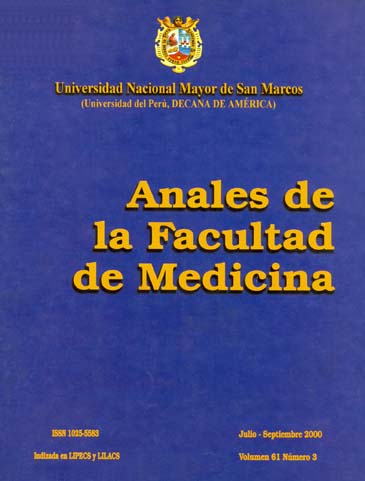Preoperative Assessment Proposal
DOI:
https://doi.org/10.15381/anales.v61i3.4345Keywords:
Intraoperative Complications, Risk, Surgery, complications, Clinical Protocols, Postoperative ComplicationsAbstract
OBJECTIVES: To design two different surgical patient groups with nonsimilar surgical risks one of them in normal range an the other in high risk. MATERIALS AND METHODS: Two groups of patients of a hundred cases each were evaluated. The first group of healthy kidney donors underwent unilateral nephrectomy, were thoroughly studied in accordance to a preestablished protocol. This protocol was analyzed and we established twelve types of surgical risks, having a risk scale that ranges from I to IV. In the second group of patients who underwent high risk major abdominal surgery we established a scoring method that allows us to determine the patient prognosis. RESULTS: The study demostrated differences in the preoperative assessments.In the fisrt group 99,75% of patients presented risk I, in the other group more than 40 % presented risk II to IV. The morbimortality had a significative difference: 1 % in donors and 19% in the ones of major surgery. Only in the second group there was 4% of mortality. CONCLUSIONS: Group I patients had excellent course, high risk patients had high morbi-mortality, the here proposed preoperative assessment must be used in high risk patients since it allows us to establish the patient prognosis.Downloads
Published
2000-09-18
Issue
Section
Trabajos originales
License
Copyright (c) 2000 Víctor Macedo Peña, Pedro Cornejo, Roberto Ventura, Helena Hinostroza

This work is licensed under a Creative Commons Attribution-NonCommercial-ShareAlike 4.0 International License.
Those authors who have publications with this magazine accept the following terms:
- Authors will retain their copyrights and guarantee the journal the right of first publication of their work, which will be simultaneously subject to Creative Commons Attribution License that allows third parties to share the work as long as its author and its first publication this magazine are indicated.
- Authors may adopt other non-exclusive licensing agreements for the distribution of the version of the published work (eg, deposit it in an institutional electronic file or publish it in a monographic volume) provided that the initial publication in this magazine is indicated.
- Authors are allowed and recommended to disseminate their work over the Internet (eg: in institutional telematic archives or on their website) before and during the submission process, which It can produce interesting exchanges and increase quotes from the published work. (See El efecto del acceso abierto ).
How to Cite
1.
Macedo Peña V, Cornejo P, Ventura R, Hinostroza H. Preoperative Assessment Proposal. An Fac med [Internet]. 2000 Sep. 18 [cited 2024 Jul. 18];61(3):184-92. Available from: https://revistasinvestigacion.unmsm.edu.pe/index.php/anales/article/view/4345















